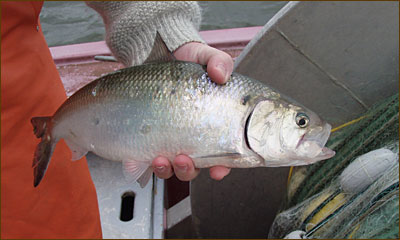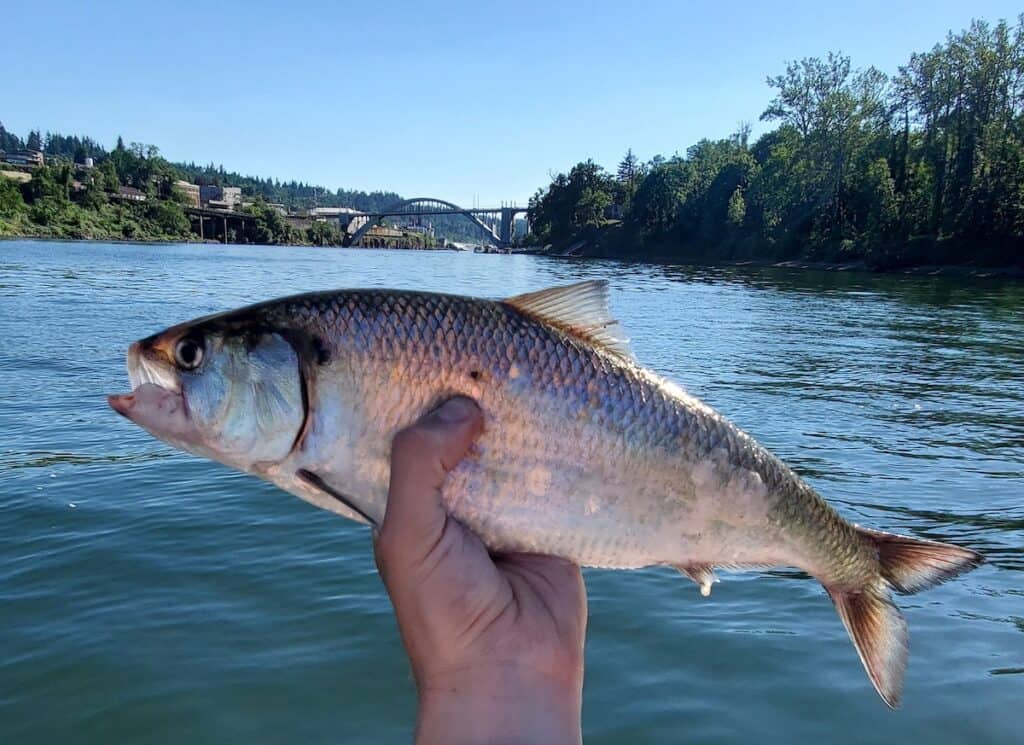Although related to herring, American shad are an excellent game fish that fight like tarpon for anglers on both the East and West coasts.
As with most salmon and steelhead, shad are anadromous, meaning they spend the majority of their lives in the ocean before returning to spawn in the freshwater rivers where they were born.
Shad were transplanted to the Pacific Ocean from the East Coast in the 1870s, with an early population making themselves at home in the Sacramento River and San Francisco Bay.
Shad came later to the Columbia River between Oregon and Washington and other river systems in the region.
These days, multiple millions of shad practically clog the fish-counting stations at Bonneville Dam and on up the Columbia River to the Snake River confluence and beyond.
Shad are great fighters for their size and offer the perfect opportunity to introduce kids and family to fishing.
It’s not unheard-of to have an 80- or 90-fish day, which will keep kids interested and perhaps skew their view of how easy fishing can be for the rest of their lives.
The range of the spawning run goes from Baja California through Coastal Alaska along the West Coast and from Florida to Newfoundland on the Atlantic Coast.
The spawn begins as early as January in the southern-most range through June and July in northern sections.
American shad are generally silvery in color with green and blue highlights. Their lower jaw fits into the upper and doesn’t protrude beyond the upper jaw.
Most shad you catch will be anywhere from 1-5 pounds, with some larger fish available. Females are often the larger fish and, unlike typical salmon, shad may survive to spawn again.
Where to Catch American Shad
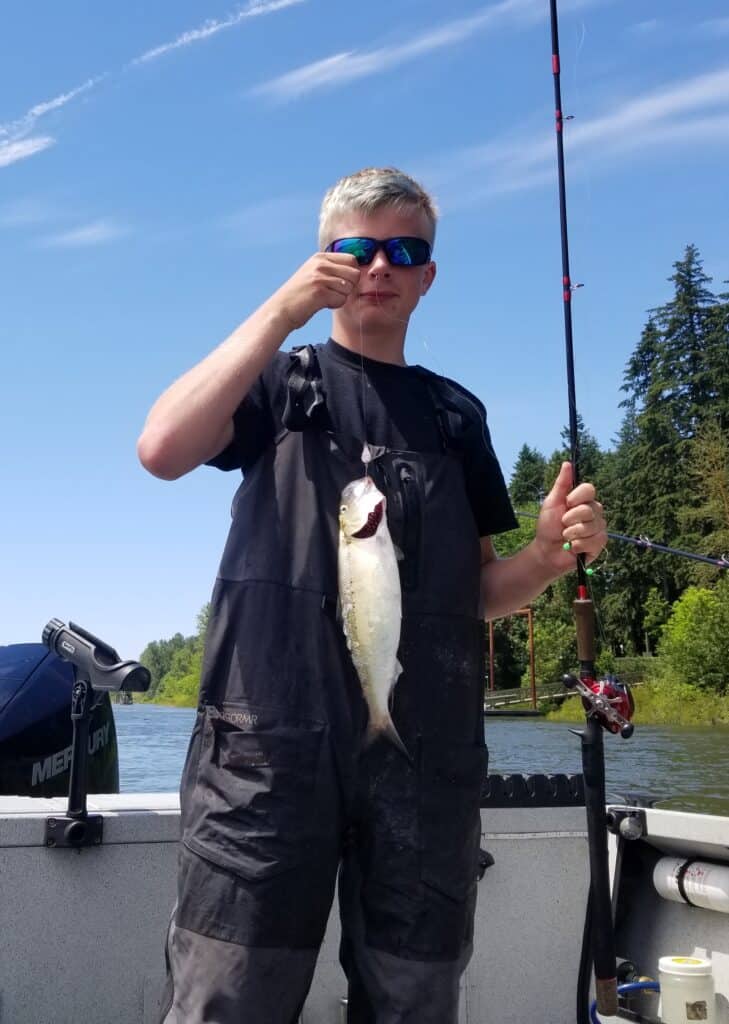
Shad are known to swim pretty close to shore, often within 30-45 feet of land, making them accessible to bank anglers, although they are even easier to catch for boaters who can park in their migration lanes.
The usual spots to target are below rocks, wing jetties, and other cover that gives them a break from the current and narrows the schools as they go around obstacles.
You will find shad at different depths, depending on the location.
On bigger rivers like the Columbia and Willamette, we’ve found them between 5 and 20 feet deep, so it can vary depending on conditions including current and sunlight.
On smaller waters, like the Umpqua River in Southern Oregon, they are often much shallower and we’ve skimmed right over the top of them in a raft in shallow water.
It’s best to find what depth and locations shad are running and stick with those. If you’re fishing even a little outside the main migration line, you can miss out.
Regular shad anglers will tell you of days where the boat right next to them was catching one shad after another using the same lures and other tackle, and it was a matter of pinpointing the right location.
On the southeastern coast, shad start their run as early January, with large numbers moving into most freshwater rivers such as the St. Johns River in Florida.
The spawn runs through April in the southern states and can last into August in the further reaches of Newfoundland.
There are similarities on the West Coast as well. The spawning run starts early in Baja, with more fish entering rivers all up the coast as the water temperatures increase.
Bank and boat anglers can both have fantastic days.
In the Southeast, bringing up to 50 fish a day to the net is common.
West Coast anglers can have equally good, if not better, fishing days on the larger rivers throughout the region.
The Columbia River between Oregon and Washington and the Willamette River in the Portland area and upriver are well known to offer fantastic shad fishing opportunities.
The run in these rivers may start earlier and stretch longer into summer, but typically the runs peak from the second half of May through June and into early July.
If you fish them from Mother’s Day through the Fourth of July, making sure you definitely hit it around Father’s Day, you should be catching shad in the Pacific Northwest’s bigger fisheries.
Along the coast of Florida and Georgia, shad are considered one of the most popular winter fish to target.
The fight is spectacular for their size, and when paired with an ultra-light rod and light tackle in lower-current rivers, will surely impress even the most cynical angler.
Light action tackle is also a great way to approach shad that are running up the Umpqua River in Southern Oregon, which can get started a bit earlier than the bigger rivers farther north.
Unlike the colossal water flows of the Willamette and Columbia, which are going to require heavier tackle to fish, the Umpqua will let you get away with ultra-light and light tackle setups, which is a blast.
When on the larger shad fishing rivers of the Pacific Northwest, look for them at around 5-20 feet deep and relatively close to shore—often within 30 feet or so.
Farther south, there is some great shad fishing in California, including big runs on the Sacramento River and several tributaries and in select coastal rivers, such as the Russian River.
Wherever you are fishing for shad, take note of the depths and possible travel lanes where other anglers are hooking the most shad.
Finding similar conditions should bring fish to your net as well, but you may need to try different depths and lanes to get them dialed in.
When to Catch Shad
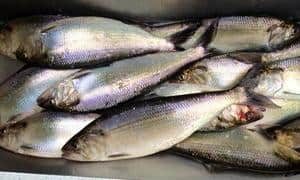
Spawn begins at different times, depending on where you are located. Warm water spurs them on, so in the southern reaches of their range, they spawn earlier than areas farther north.
Many anglers agree that the prime fishing time for shad is the hours just before dark, although when shad are thick, just about any time of day will be productive.
Since shad don’t feed when spawning, treat them as you would a salmon and try to incite a strike because the fish is annoyed. Cast shad darts and crappie jig heads in bright colors like chartreuse and green.
On overcast days, you may be able to target shad holding in shallower water or up off the bottom, and they may be resting in pools or behind breaks in the current.
When it is clear and sunny, they are going to be holding closer to the bottom and possibly in deeper water to avoid the direct sunlight.
One setback you may run into with the shad spawn is that it coincides with salmon fishing in some areas.
While it is exciting to have a salmon take your little shad lure, make sure you check for any current restrictions and regulations regarding salmon and shad for the rivers you plan to target.
For example, in my home state of Oregon, you need a special tag to harvest the bigger fish that isn’t required for shad fishing.
How to Catch Shad
Shad don’t actively feed in freshwater.
They stop the feeding cycle when leaving the ocean and are only going to strike because they are annoyed or, to a lesser extent, because they instinctively see the item as food.
The best bait for American shad are small, artificial lures including jigs, spinners, spoons and similar lures. Shiny or brightly colored lures work best, although shad also are known to bite a shiny bare hook, especially attached to a swivel to give it some swaying action.
Chucking lures like the popular shad darts from a boat or the shore will nearly always deliver results if the fish are running.
The trick with these fish is that they travel in schools. Once you find a school, you may be able to follow it and catch fish all day.
A more common approach, at least in some waters, is to set up in an area where you have learned the schools will pass during their migrations. If the run is going strong, you likely won’t have to wait all that long.
Set your rod up with 6- to 12-pound test and use lures or hooks around a 1 or a 1/0 size.
In most waters, shad tend to hold in the slow- to mid-flow sections and are going to be hanging out a bit deeper when it’s light out.
They are known to have a light aversion, so morning and evening fishing and overcast days tend to lead to stronger bites and may allow a shallower approach.
If it’s bright and sunny, you may find more success by fishing in 15 feet or so of water, depending on location and other factors.
On major rivers, target areas just below obstructions.
Think of the Columbia River and how there are several major dams up its length. In the waters before these dams, shad will stack up in thick schools before climbing fish ladders.
Once you find these schools, you’ll be in for a great day of fishing.
Boat Fishing for Shad
Lures cast from boats work very well. Boats make it a bit easier to find the schools and either move with them or park in their travel lanes.
The best way to catch from a boat is going to vary, depending on water conditions and whether or not the shad are in the mood for the colors you are tossing.
Drop your anchor along the side or just above a holding area, but be sure you have the appropriate equipment.
Anchoring in the deceptively powerful current of large rivers can be a risky business if you don’t come well-equipped or don’t know what you are doing.
Some anglers will cast from a boat while others will run their lure back behind the boat, with the lure coming off a dropper with enough weight below to drop the lure right into fish-holding depths.
You may or may not use a rod holder with the latter approach, but you must be ready to act quickly.
A very popular strategy that is deployed across the northeastern coast is to let the lure or jig drift along and then “dangle” on the end of the line.
Letting it sit like that can be very productive or can miss the school entirely. Schools of shad are long and skinny, not short and fat, so it’s easy to be fishing next to a school and not get a bite.
A simple setup is to attach a 3-way swivel to your mainline, then connect a 3- to 4-foot leader to one loop and the lure or spoon. Add a 2-foot dropper line with enough weight for the conditions and then lower the setup to the bottom behind your anchored boat.
The lure will do all the work moving in the current, and when a school comes along, you’ll have some pretty fast action.
You’ll need a light- to medium-action rod for most shad fishing. Your bass or trout rod will often do the trick.
In strong currents that require up to several ounces of lead to reach the fish, you might need to grab your next heaviest rods.
Bank Fishing for Shad
Shad fishing is one of the best options for bank anglers to get involved in a spawning run.
Shad like the shallower, slower sections that are easier to access from the bank than, say, salmon, who stay in deeper, harder to reach sections.
Head out to the nearest river holding shad, set up on the bank with a 7-foot light-action rod and 6- to 12-pound test. Heavier tackle also is appropriate for heavier currents, so I have used my steelhead rod at times.
One approach is to employ a shad dart beneath a slip bobber. The slip bobber will allow you to easily adjust the depth the lure is running at and will provide an even, natural flow through the water.
If the bobber isn’t working out, change up your tactics and try drift fishing by adding some split shot, a slinky or other weight about two feet up from the lure.
As the lure or jig moves through the area, lift your rod tip every few seconds. The irregular movement causes the lure to move erratically, which may trigger an otherwise uninterested shad to bite.
The Best Shad Lures
Now to some lure choices.
Shad darts are a longtime go-to for these fish. Traditional color patterns include red and white, but other bright-colored dart-style lures will catch shad.
There are a good number of small spoons, simple spinners and crappie-style weighted jig heads with bright twisty-tails that will account for lots of hooked shad.
We’ve caught shad on a simple nickel siwash hook pinched to a good-sized barrel nickel-plated swivel, which makes a slow but enticing motion in current.
Similarly, other anglers swear by simply threading 3-4 colorful and/or metallic beads on the line above a single hook will do the trick using a similar rig.
For some presentations, such as using a dropper with weight on the bottom, some anglers will use two lures, often two different types such as a small spoon and a shad dart.
Lures for shad fishing are going to come in all sorts of sizes, but the standard, most popular sizes are 1/16 and 1/8 ounces.
For small spoons, spinners and similar lures fished above a weight, or in many cases used in drift fishing, light-weight lures with action in the current tend to score plenty of strikes.
While a variety of colors will work for shad, definitely include some bright chartreuse and green in your arsenal.
Fly Fishing for Shad
Shad on the fly can be a fantastic fight. Use a five weight with floating line and a sinking tippet.
The fly needs to sink, but with a floating mainline, you can quickly determine the proper depth.
Most shad flies are brightly colored. Casting flies like Crazy Charlies, Clousers, Woolly Buggers, and other similar patterns can work well.
If you are wary of trying out shad on the fly, don’t be. There is a good reason their nickname is “little tarpon.”
Are Shad Good to Eat?
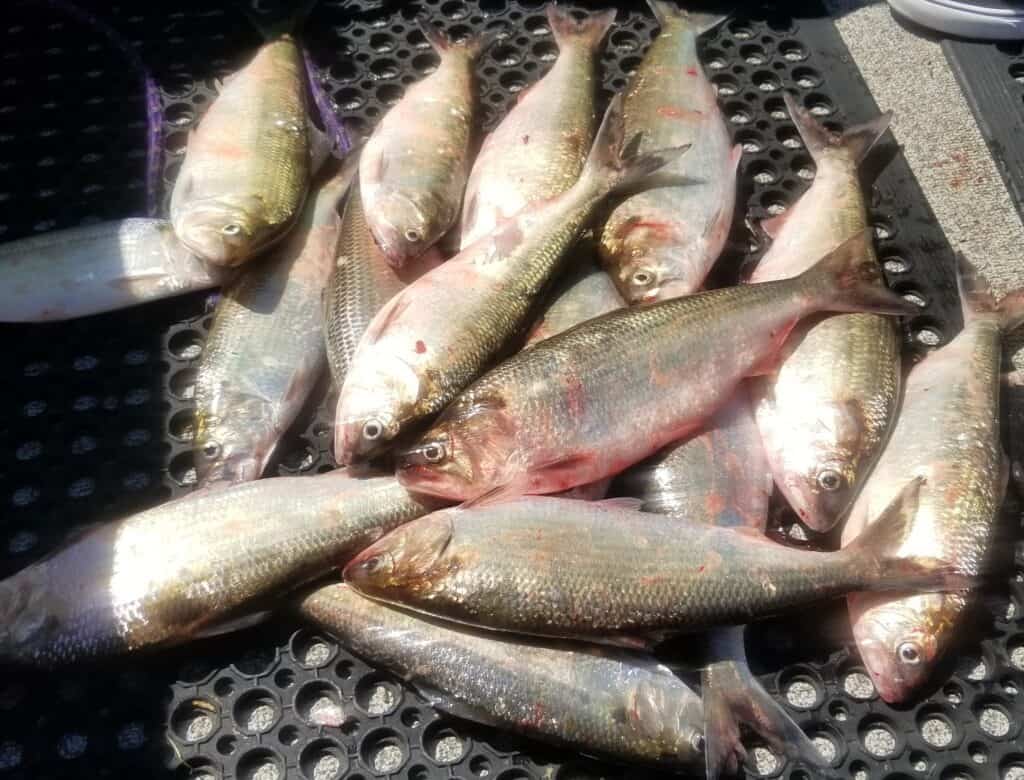
This answer will depend on who you ask and what dishes they prefer to eat.
Shad are particularly bony, which makes them more difficult to prepare and eat unless you are canning them, which softens to small bones enough to simply eat.
Boiling or smoking them makes the bones easier to remove. I’ve eaten them smoked and enjoyed them, but honestly I don’t like them as well as many other fish species.
Shad also tend to be oily, which impacts their flavor.
Depending on your cultural food preferences, shad may be your ideal food fish. When I’ve fished popular shad spots, it’s often a mix of anglers speaking languages from around the world.
Some people also love to eat shad roe, which can be prepared in several ways. Again, it’s not my favorite but anglers who prize the roe will especially want the egg-filled female fish.
Like their smaller herring cousins, shad also make excellent bait.
I have used them to catch sturgeon and Dungeness crabs, and I know of a few people who use shad cut-bait for catfish.
For sturgeon fishing, strips of shad meat work well for typical-sized fish while whole shad can be deployed for catching and releasing massive fish.
For crabbing, slice the carcass crossways a few times on each side to release more scent, but be aware that seals and sea lions love fresh fish and are likely to steal your bait right out of your traps if these big marine mammals are anywhere nearby.
On the West Coast where shad are non-natives and sometimes run in river-filling numbers, some people even harvest them as garden fertilizer.

